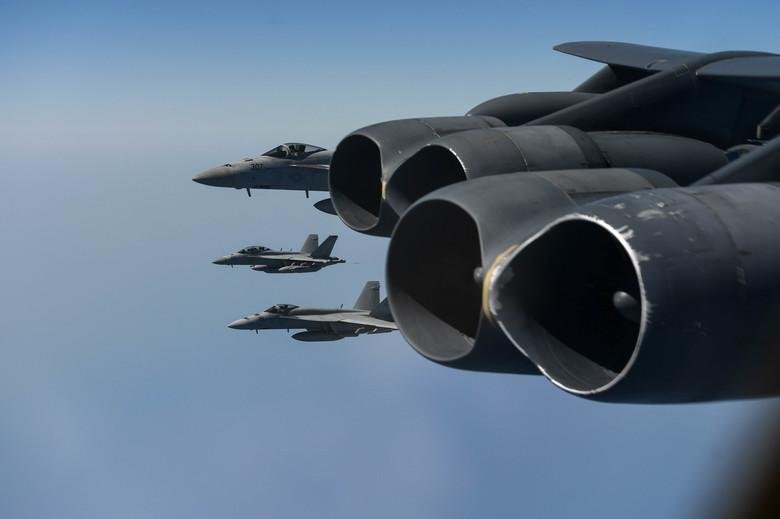1 of 2 | U.S. Navy F-18 Hornets form up off the wing of a U.S. Air Force B-52H Stratofortress during joint exercises Saturday in the U.S. Central Command area of responsibility in the Arabian Sea. Photo by Staff Sgt. Erin Piazza/U.S. Air Forc
June 3 (UPI) -- F/A-18E Super Hornets and E-2D Advanced Hawkeyes from the U.S. Navy's Abraham Lincoln Carrier Strike Group and the Air Force's B-52H Stratofortress conducted joint exercises in the Arabian Sea amid rising tensions with Iran.
The Stratofortress, a long-range bomber assigned to the 20th Expeditionary Bomb Squadron and part of the U.S. Central Command Bomber Task Force, participated in the drills with Lincoln's Carrier Air Wing 7 on Saturday, U.S. Central Command said Monday.
MH-60R Sea Hawk helicopters also embarked from the the Nimitz-class aircraft carrier.
"It's a pretty awesome feeling to look up and see our jets flying alongside the Air Force bomber," Capt. William Reed, commander of CVW-7, said in a news release. "The training the air wing conducted with the B-52's today is an incredible demonstration of how our military can to rapidly join capabilities to enhance our lethality and our ability to respond to any threat when called upon."
In May, four B-52 bombers and the Nimitz-class aircraft carrier, with its carrier air wing, Ticonderoga-class guided-missile cruiser USS Leyte Gulf, and destroyers USS Bainbridge, USS Mason and USS Nitze, were dispatched to the Middle East. Acting Defense Secretary Patrick Shanahan told a Senate Appropriations Defense subcommittee last month there was "very, very credible" intelligence that Iran was preparing to attack U.S. forces or interests in the region.
The training gave both sides the chance to interact with aircraft designed to improve operational tactics in several warfare areas. Exercises included air-to-air training, flying in formation and simulated strike operations in defense of a national asset.
The Super Hornets and Advanced Hawkeyes conducted a self-escort strike with the bomber. The Lincoln aircraft simulated opposing, as well as friendly, forces.
"While the Air Force trains different assets together all the time, including Navy F-18s, we typically don't have the opportunity to integrate with the surface fleet," said Lt. Col. Scott Mills, 609th Air and Space Operations Center air and space strategist. "As we train together, it gives us the chance to examine the bias we each bring to the engagement. We each learn about the other's domain by searching for areas where we operate differently."
Since 1955, the Air Force has operated the B-52H, which has a typical combat range of 8,800 miles and can carry up to 70,000 pounds of weapons. Because it has anti-ship and mine-laying capabilities, it can assist the Navy in ocean surveillance.
"Each of our respective services influences the other," Mills said. "Today's mission represents our ability to project air and sea power around the globe. When we act, we do so as one force, not separate services. Exercises like the one held today ensure that can operate anywhere, anytime."
Boeing's single-seat F/A-18E and double-seat F/A-18F Super Hornets replaced the Hornet. The aircraft was deployed into combat for the first time aboard the Lincoln in July 2002, according to the Navy.
The E-2D Hawkeye, built by Northrop Grumman, is the newest variant of the E-2 aircraft platform, which entered service in 1964. The E-2D, which entered service in 2014, is described by the Navy as an all-weather, carrier-based tactical battle management airborne early warning, command and control aircraft."
Lt. Gen. Joseph Guastella, Combined Forces Air Component commander, was pleased with the operation
"This operation allowed us to train interoperability, focus on defense and interdiction, and provide air support to our naval fleet defense," Guastella said. "Our land, air, and maritime assets are even stronger and more effective when integrated together. We are postured to face any threats toward U.S. forces in this region."
The Lincoln strike group entered the European theater in April. It departed from Norfolk, Va., and will ultimately head to San Diego, its new home port.
The U.S. Navy posted photos of the exercises on Twitter, saying they were "demonstrating teamwork and power in the Arabian Sea.
And the Air Force posted on Twitter, "Bombers, CSG integrate to show joint flexibility."















